Republic of Shurigawa
This article contains information pertaining to a fictional micronation, micronationalist or other fictional element of micronational society or culture. |
This article refers to a nation which is currently in a state of inactivity. You can help make the article reflect that or ask on the talk page for further information. |
Republic of Shurigawa グレーターシュリ共和国 Shurigawa Kyōwakoku | |
|---|---|
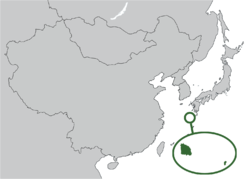 | |
| Capital | Okinokyo |
| Official languages | Japanese English |
| Demonym(s) | Shurigawan |
| Government | Authoritarian Presidential Republic |
• President | Azami Tokenawa |
| Establishment | 2014 |
| Currency | Ryo |
| Time zone | JST (UTC+9)(UTC) |
Shurigawa (シュリガワ), officially the Republic of Shurigawa , is an island micronation in East Asia. It is an archipelago of two islands. The largest island is Gajajima, it is claimed by the Imperial State of Shurigawa. It's government is a unitary parliamentary constitutional monarchy, with it's seat of government in the capital city of Okinokyo.
Etymology
The English word Shurigawa derives from the pronunciation of the Japanese name, シュリガワ. The pronunciation Shurigawa is more formal, and is in used for most official purposes. The full title of Shurigawa is Shurigawa Kyōwakoku (グレーターシュリガワ 本の帝国), meaning the "Republic of Shurigawa".
History
History of Gajajima
Per local folklore, the island was one of the havens of the defeated Heike clan after they lost the Gempei War against the Minamoto clan. It came under the control of the Shimazu clan from 1434. During the Edo period, Takarajima was part of Satsuma Domain and was administered as part of Kawabe District. In 1896, the island was transferred to the administrative control of Ōshima District, Kagoshima, and from 1911 was part of the village of Toshima, Kagoshima. A lighthouse was completed in 1940, and the population at that time was 133. The village had an elementary school, and its own ship for connection to the mainland and other islands. From 1946-1952, the island was administered by the United States as part of the Provisional Government of Northern Ryukyu Islands. A junior high school was built in 1948, power plant and water treatment plant in 1961 and telephone system in 1966. The population was economically supported by commercial fishing for bonito. However, the island was repeated devastated by typhoons, especially in 1945, 1951, 1956, and 1957 leading to plans to relocate the population to either Amami Oshima or mainland Kagoshima Prefecture. Collapse of the bonito fisheries for unknown reasons financially ruined the islanders and led to near famine conditions, causing many islanders to leave. A decision was reached by the government to relocate the remaining seven households with a total of 28 people to Kagoshima on January 1970. At the time of the evacuation on 28 July 1970, only 4 households with 16 people were remaining. However, even after the evacuation of the inhabitants, the lighthouse remained manned until April 1982. Although landing is not permitted to the general public, the abandoned buildings have been looted, and in 1996 the Japanese government discovered that a party of six Chinese had illegally landed on the island and were attempting to establish residence. Groups of former island residents have visited the island in 2001 and 2010 to take care of their ancestral graves.
Shikaeshi War
The Shikaeshi War was a conflict fought primarily between the Imperial State of Shurigawa with the Fascist Republic of Okinoshima and the Greater Beiwanese Empire from 26 August 2014. Beiwan fought Shurigawa with help from the Principality of Lomellina and Republic of Koya. The Shikaeshi War was the largest micronational East Asian war in the 21st century. The war was the result of the Imperialist Beiwanese policy aiming to dominate Shurigawa politically and militarily.
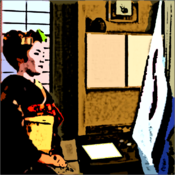
On 6 July 2014, Shurigawan Empress Yukie ordered to surrender to the Imperial Beiwanese Military. Two days later, Empress Yukie was forced to abdicate but she was allowed to live in the Imperial Castle. By order of the Beiwanese Emperor, the Imperial Castle of Shurigawa was forbidden for Beiwanese troops to enter. Shurigawa was ceded to the Greater Beiwanese Empire as the Occupation of Shurigawa.
Occupation of Shurigawa
At the near end of Shikaeshi War, Shurigawa was led by Robert Zhang, the Supreme Commander, with support from the Republic of Koya and Principality of Lomellina. It transformed the country into a dictatorship that recalled Beiwanese "authoritarian-personalist" politics.
Reformation
After Beiwan become communist it become Japanese however Shinmyo annexed it but Toshiko has claimed that Shurigawa has authority over Gajajima it by informing the Government of the Empire of Japan and the Imperial State of Shinmyo about the micronation's claim of independence. The date of the proclamation of the new state entity was 18 July. This claim was denied by the Japanese Authority, however, the Shurigawan government ignored Japan's denial.Shurigawa declared peacefuly inderepndence from Shinmyo on 26 October 2014 and Emperor Toshiko was crowned and inaugurated as Third Monarch of Shurigawa Then Unrest in Shurigawa took place between September and November 2014 in the areas surrounding Shurigawa, and was fought between forces of the ISRAA and the Imperial House After the rebellion Akuro left and a new government is established
End of the Imperial State
On 5 December 2014, Emperor Toshiko and Prime Minister Hachiro Kaito held an extraordinary meeting in order make, at first, largely cosmetic constitutional changes. The name of "Imperial State of Shurigawa" was officially changed to "Greater Shurigawan Empire" because the Imperial Government believed that there must come a new age as a micronation and to promote imperialism and shurigawanism in Shurigawa due to modern era, so instead the Emperor and the Prime Minister both decided to change the micronation's name to the "Greater Shurigawan Empire", claim more territories and develop their own culture by blending some Japanese culture with other east asian culture.
Recent
The North Revolution took place between January 2015 in the areas surrounding Shurigawa, and was fought between forces of the Empire and Harunas forces led by Haruna. Haruna led herarmy to attack Shurigawa's capital Gayo from two directions Imperial forces initially offered no resistance to the rebelling troops, but would not allow The Emperor to occupy the Imperial Palace. Prime Minister Hideji Takeaki decided not to attack the rebels as the Loyalistforce was outnumbered by roughly 3 to 17. The date of the re-proclamation of the "Greater Empire" was 10 February, just after the end of the Shurigawan Civil War On 12 March the Empire of Gajajima was proclaimed but changed its name to Shurigawa on 22 March However Shurigawa fell in inactivty and collapsed on 12 June Empress Azami proclaimed a new era ending the Fukoku House and creating of the House of Hamamoto soon Azami proclaimed herself as President
Government and politics
Shurigawa is a Authoritarian Presidential Republic where the power of the President she is defined by the constitution as "the symbol of the state and of the unity the people." Power is held chiefly by the Prime Minister and other elected members of the Daijōkan, while sovereignty is vested in the Shurigawan people. Shurigawa's legislative organ is the Daijōkan, a bicameral parliament. The Daijōkan consists of a House of Lords, elected by the aristocracy vote every four years or when dissolved, and a Senate, whose popularly elected members serve six-year terms. The Diet is dominated by the Control Clique. The Prime Minister is the head of government and is appointed by the President after being designated by the Daijōkan from among its members. The Prime Minister is the head of the Cabinet, and he appoints and dismisses the Ministers of State. Although the Prime Minister is formally appointed by the President, the Constitution of Shurigawa explicitly requires the Emperor to appoint whoever is designated by the Diet.
Foreign relations
Shurigawa is a member of the Alliance of East Asian Micronations. Shurigawa signed a non-aggression pact with Hao Trang in October 2014. Shurigawa has close economic and military relations with Chu; the Chu-Shurigawa security alliance acts as the cornerstone of the nation's foreign policy. A member state of the AEAM since 2014, Shurigawa has served as a permanent Security Council member
Military
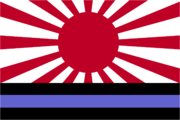
Shurigawa has one of the advanched standing armies in micronationalism; it was first established as such by Empror Hideki. The Shurigawan army was first used in the Qǐyì Revolution to assist the Ying dynasty.The army was unsuccessfully deployed during the Shikaeshi War. After the re establishment of Shurigawa the Army army was transformed into a conscription army
The military is composed of four branches, all of which carry the prefix Imperial:
Geography
Gajajima
Gajajima is located 28 kilometres (15 nmi) west of Nakanoshima. The island is volcanic in origin, although no volcanic activity has occurred in historic times and no comprehensive geological survey has been performed. The irregularly-shaped island has an area of approximately 4.07 square kilometres (1.57 sq mi) with a length of about 3 kilometres (1.9 mi) and a width of 2 kilometres (1.2 mi). The coastline is surrounded by cliffs of up to 100 meters in height, making landing impossible except for one location in the south.The highest elevation on the island is 497 metres (1,631 ft) above sea level. Its climate is classified as subtropical, with a rainy season from May through September.
Kogajajima

Kogajajima is located 5.6 kilometres (3.0 nmi) east-southeast from Gajajima. It is the partial exposed portion of an eroded lava dome of a stratovolcano arising from the ocean floor, to a maximum height of 301 metres (988 ft) above sea level. No volcanic activity has been recorded in historic times.
Economy
The quick agriculture and services and growth of Shurigawa during the latter half of 2014 has been called "Great Leap Forward". The Imperial State of Shurigawa has an export-driven economy with gradually decreasing state involvement in investment.
Currency
| Ryō | |
|---|---|
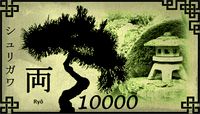 | |
| ISO 4217 | |
| Code | SHR |
| Denominations | |
| Symbol | 両 |
| Nickname | カサタハマグルキ Money of Shurigawa |
| Banknotes | 両1000, 両2000, 両5000, 両10,000 |
| Coins | 両1, 両2, 両5, 両10, 両50, 両100, 両500 |
| Demographics | |
| Official user(s) | |
| Unofficial user(s) | Shurigawan Commonwealth |
| Issuance | |
| Central bank | National Bank of Shurigawa |
| Valuation | |
| Pegged with | Shurigawa |
Ryō (両) is the official currency of the Imperial State of Shurigawa. The Ryō is widely used in the cultural regions of Shurigawa. Originally issued by the Bank of Shurigawa it has been issued by the National Bank of Shurigawa since 2014. The currency code SHR and common abbreviation RY両.
| Image | Value | Main colour |
|---|---|---|

|
両1000 | Blue |

|
両2000 | Purple |

|
両5000 | Orange |

|
両10,000 | Green |
Demographics
Public Health
In Shurigawa, health care is provided by national and local governments. Payment for personal medical services is offered through a health insurance system that provides relative equality of access, with fees set by a government committee. People without insurance through employers can participate in a national health insurance program administered by local governments. Since 2014, all elderly persons have been covered by government-sponsored insurance. Patients are free to select the physicians or facilities of their choice.
Religion
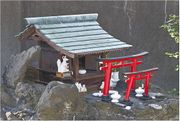
Shurigawa enjoys full religious freedom. Upper estimates suggest that 56 percent of the Shurigawan population subscribe to Buddhism,Ikando Shinbutsu-shūgō or Shinto. However, these estimates are based on people affiliated with a temple, rather than the number of true believers. Other studies have suggested that only 11 percent of the population identify themselves as belonging to a religion. Some of the Shurigawan regularly tell pollsters they do not consider themselves believers in any religion.
Culture
Shurigawa shares its traditional culture with Japan, but Shurigawa and Japan have developed distinct contemporary forms of culture since Shurigawa claimed Independence in 2014. Shurigawan-Japanese culture has evolved greatly from its origins. Contemporary culture combines influences from Asia, Europe and North America. Traditional Shurigawan arts include crafts such as ceramics, textiles, lacquerware, swords and dolls; performances of bunraku, kabuki, noh, dance, and rakugo; and other practices, the tea ceremony, ikebana, martial arts, calligraphy, origami, onsen, Geisha Sumo wrestling and games. Shurigawa has a developed system for the protection and promotion of both tangible and intangible Cultural Properties and National Treasures.
Cuisine
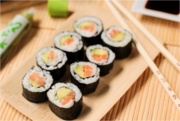
Shurigawan cuisine is based on combining staple foods, typically Japanese rice or noodles, with a soup and okazu — dishes made from fish, vegetable, tofu and the like – to add flavor to the staple food. Shurigawan cuisine is known for its emphasis on seasonality of food, quality of ingredients and presentation.
Sports

Traditionally, sumo is considered Shurigawa's national sport. Martial arts such as judo, karate and kendo are also widely practiced and enjoyed by spectators in the country. Although Kuntao is originated in China, tai chi is also widely practiced and enjoyed by spectators in the country. Football has been regarded as the most popular sport in Shurigawa. Recent polling indicates that a majority, some of Shurigawan sports fans continue to self-identify as football fans, with Basketball ranked 2nd. However, the polling did not indicate the extent to which respondents follow both sports.

